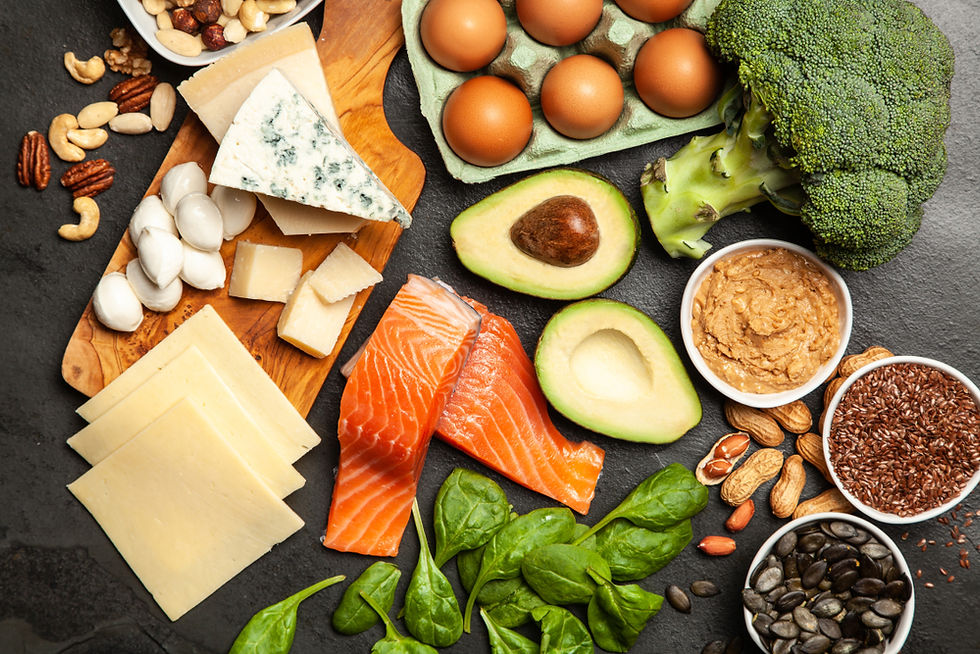DETERMINING THE IDEAL SQUAT FOR YOUR FITNESS GOALS
- Sara Sutherland

- Jul 11
- 3 min read

Choosing the right squat load position is crucial for optimizing your strength training routine. Each type of squat targets different muscle groups and has its own benefits and challenges.
Let's explore the various squat techniques, including back, front, Zercher, goblet, safety bar, and high-bar vs. low-bar squat variations.
Back Squats: High-Bar vs. Low-Bar
Back squats are a cornerstone of strength training. The high bar squat positions the barbell on the upper traps, leading to a more upright torso and greater quadriceps activation. This variation is often used in Olympic lifting due to its emphasis on upright posture and knee mechanics.
Conversely, the low-bar squat positions the barbell lower on the back, around the rear deltoids. This requires a forward lean, which shifts the emphasis towards the posterior chain, including the glutes and hamstrings. Low-bar squats allow for lifting heavier weights and are favored in powerlifting because of their capacity to engage larger muscle groups.
Both high-bar and low-bar squats have their merits. High-bar squats are generally easier to learn and are better for building quad strength, while low-bar squats are suitable for those aiming to maximize overall strength and lift heavier loads.
Pros:
● Ideal for building overall strength and muscle mass.
● Engages multiple muscle groups, including the glutes, hamstrings, and lower back.
Cons:
● It can place significant stress on the lower back and shoulders.
● Requires good shoulder mobility and balance.
Front Squats: Emphasizing Quads and Core
Front squats involve holding the barbell across the front of the shoulders, which promotes an upright torso and places significant emphasis on the quadriceps and core. This squat variation reduces strain on the lower back and is excellent for improving mobility in the hips and ankles. The upright posture required for front squats enhances core stability and improves overall squat mechanics.
However, front squats require good shoulder and wrist flexibility, and the amount of weight that can be lifted is typically less compared to back squats. Despite this, front squats are highly effective for targeting the anterior chain and improving overall leg strength.
Pros:
● Encourages an upright torso, reducing lower back strain.
● Enhances quad and core strength.
● Improves mobility and flexibility in the hips and ankles.
Cons:
● Limits the amount of weight compared to back squats.
● It can be uncomfortable for those with limited shoulder and wrist flexibility.
Zercher Squats
Zercher squats are performed by holding the barbell in the crook of your elbows, which rests at the front of your body. This unique positioning engages the upper back, biceps, and core more intensely than other squat variations. Zercher squats promote a more upright posture, reducing lower back strain and enhancing grip strength.
While Zercher squats can be uncomfortable on the arms and elbows, they are excellent for diversifying your squat routine and building upper body strength. They are particularly useful for improving overall functional strength and posture.
Pros:
● Targets the upper back, core, biceps, and legs.
● Promotes a more upright posture, reducing lower back strain.
● Enhances grip strength and forearm endurance.
Cons:
● Can be uncomfortable or painful on the arms and elbows.
● Typically, lifters can handle less weight compared to back or front squats.
Goblet & Safety Bar Squats
Goblet squats are an excellent introduction to squatting, particularly for beginners. In this variation, you hold a dumbbell or kettlebell close to your chest, which helps maintain an upright posture and balance. Goblet squats encourage proper squat form, making them ideal for those new to strength training or looking to refine their technique.
Although goblet squats limit the amount of weight that can be used, they effectively engage the core and upper body for stabilization. This makes them beneficial not only for beginners but also for more experienced lifters as a warm-up or accessory exercise.
Unlike the goblet squat, safety bar squats aren’t limited by the weight you can use doing them.
Safety bar squats use a specialized bar with padding and handles, reducing shoulder strain and providing greater stability. The bar's design allows for a more upright torso, similar to the front squat, but with added comfort and balance.
This makes safety bar squats an excellent option for those with shoulder mobility issues or who experience discomfort with traditional barbell squats.
CONCLUSION
Selecting the right squat load position depends on your fitness goals, experience level, and any physical limitations.
Incorporating a variety of squat positions into your routine can help you achieve a well-rounded lower-body workout and avoid plateaus. By understanding the benefits and challenges of each squat variation, you can tailor your training to best suit your needs and goals.









Comments